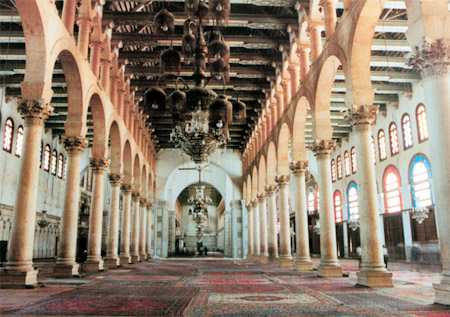
Journey to Bilad Asham (Syria) [Archives:2001/30/Last Page]
July 23 2001

Ridhwan Al-Saqqaf
Chief of Aden Bureau
Syria is one of the Arab countries that overlook the Mediterranean sea with beaches of about 183km long. To the north is Turkey, to the east is Iraq, to the south is Jordan, and Lebanon and Palestine are to west. It has a total area of about 185km with a mountain range such as Lebanon, Algmon, Arab, and Abdulaziz mountains besides the interior range like the southern and northern Tadmor range.
Rivers
There are many rivers crisscrossing the Syrian lands. The most important of these are the Euphrates river with 680km long Alasi 366km and Barada and Alaawaj rivers in Damascus and Alyarmok in the south and Afreen in the north. Beside these, there are many rivers in the coastal area such as the northern and southern great rivers as well as San in the middle. Also there are several lakes. Some are with fresh water such as Katina and Muzyrib whereas some are salty as Ajabool, Jyroud, Almawj and Albwara. Moreover there are some artificial lakes behind the dams where the most important is the Alasad behind the Euphrates and the 6th of Teshreen on the northern great river.
Historical Monuments
Syria is distinguished by one of its historical and archeological monuments which make it as a real natural museum for all eras. Damascus the largest ancient city with its ancient attractive markets and baths.
Ummayid Mosque in Damascus
Before establishing the Ummayid mosque there was a small mosque founded by Muslims. It was independent from the church but shared a same fence which is known the hedge of the temple. This neighborhood between the mosque and the church lasted for about 70 years.
As the Muslim Caliph Walid Bin Abdulmalek took over the leadership of the Islamic state, he decided to establish a mosque that would suit the multitude of the Islamic state. Besides, the old mosque became insufficient for the increased numbers of Muslims. The building process of the new mosque lasted from 705 to 710 AD and it was featured as a unique project distinguished by its architectural wonders. Some historians mentioned that the cost expense of this mosque reached 22,800,000 Islamic Dinar and some said it was 5,600,000 Dinars.
After Omar Bin Abdulaziz came to the throne, he did not agree on the extravagance in the mosque and wanted to take some of the rare thing in the mosque and to return them to the treasury of the state.
It is narrated that a Roman messenger visited Damascus once and he visited the mosque. When he watched the architecture wonders in the mosque, he fainted. As he got up he said that Romans will not be able to come again to this land which became for Muslims from now and ever.
Mosque Description
The mosque is rectangular in shape with 156m long and 97m wide with three main gates connect it with the eastern, western and northern sides of the city. The fence of the mosque is built with stones of the ancient temple. There are square towers in the corners of the old fence which were used after the Islamic conquer as minarets for the mosque. The eastern gate is still the same as in its first time and the prayer yard is rectangular in shape and paved with marbles. Historians mentioned there are three small buildings in the prayer yard to the west where the treasury is being. The mosque from inside has three proselytes opposite ALKIBLA and in the middle a dome with about 36m high based on four huge poles. This dome is called ANASSR.
Prophet Yahia’s Grave
Inside the mosque there is an elegant small building stands between the middle priestly poles to the east. It’s the grave of the prophet YAHIA peace on him (Saint John) as Christians call him. Historical signs prove that this grave was found in the place of the mosque as it was built and the Caliph Walid ordered to keep it and to be built on a distinguished pole. Later it was covered with wood inlaid with gold.
Saladin’s Grave
Outside to the northern side of the mosque there is the Azizias School which was founded by Authman Bin Salah Adeen in 1195 AD to include his father’s grave who died in 1193 AD.
There is also the mosque of Sayida Roqia near the Ummayid mosque. In the middle of the mosque stands her grave.
Windows of the Mosque
The light goes to the mosque through 48 windows on the northern and the southern. These windows are similar to those (KAMERIES )in Yemen.
Decorations
The mosque was decorated with designs comprising of two main elements which are mosaic and marble. The latter covers the ground with 4m high. The designs are covering all corners.
The mosque also include the grave of AL HUSAIN BIN ALI BIN ABI TALIB which contains his head. The grave is square with golden decorated poles.
The visitor to Damascus city will find the old Islamic life in which Muslims after 200 HIJRA as well as the great archeological monuments which distinguishes this city from other cities.
——
[archive-e:30-v:2001-y:2001-d:2001-07-23-p:./2001/iss30/lastpage.htm]


